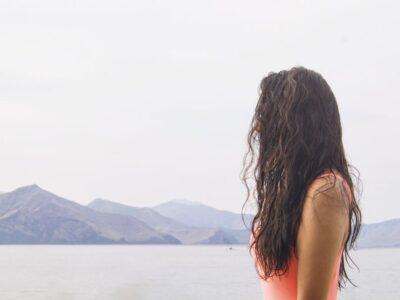I’m sitting in the cabin of a 10-ton snowcat as it climbs into the extreme skiing backcountry of Keystone Mountain. Trudging along a narrow forested pathway, the machine’s tank-like treads grip the abundant snow. What I’ve come for is a freeing dose of waist-deep powder, and the type of backcountry skiing that only the Rocky Mountains can provide. Around me are 11 strangers who have come for the same. Our childlike grins and excitable chatter prove infectious, even to the three guides who spend their days out here, living the rush that we’ll only borrow for a day.

James, our hulking, heavily bearded, and exceptionally friendly guide mentally prepares our group as the cat continues its march toward the mountain’s upper bowls. He tosses out references to the “north facing runs” that we’ll start off with on Bergman Bowl. He says that we’ll let “the solar work its magic” on Erikson Bowl before skiing it in the afternoon, and uses words like “crunch” and “bounce” to describe the snow. His compatriots – Nobu, a fearless snowboarder and an impressive heavy-machinery driver from Japan, and Jeff, a snow patroller and member of the mountain’s avalanche-blasting team – chime in with more of the same. I nod along like I have the slightest idea what they’re talking about.
But I don’t have to, and that’s the point. It’s a Keystone KAT Skiing Tour. The only prerequisite is expert skiing ability (and a few hundred dollars to spare). For the most part, the members of our group have little knowledge of the backcountry and live far away from the Rocky Mountain’s endless succession of snowstorms. So we’ve found an opportunity to get carted and guided into premier terrain during our brief visit, and without the risks – or the hours – it would take to hike our way in. This tour, which is offered in similar incarnations at a handful of other Colorado resorts including Vail and Steamboat, allows us to pack a year’s worth of powder skiing into a day, and live to tell the tale.
What makes it all possible is the snowcat: a critically important machine to the modern-day ski resort. Snowcats typically spend each night grooming their mountain’s most popular runs under the control of skilled operators. But a select and lucky few, like the bright red behemoth I’m riding in, have been specially outfitted for passenger carrying.
Our plush 12-seater edges along the forested path until we sneak out, suddenly above the altitude where the pines will grow. The windows now reveal gargantuan space, populated with undulating peaks and valleys. The cat follows the ridge and then Nobu throws it into whatever its version of the park is, running around to the back to open our door. One by one, we lower our goggles and emerge into the bright morning. Around us are three eggshell-white bowls, sculpted-smooth beneath their respective summits. These are Independence, Bergman, and Erikson. We have arrived.
The steps to the snowcat hang two feet above the ground and I launch myself off them into thick, cushiony snow, poles in hand. James, Jeff, and Nobu unstrap the fat Solomon powder skis that were included with the tour from the cat’s carrying rack, along with the snowboarders’ boards, which they had to bring for themselves. I quickly strap on my gear, treating this like any other run, but I’m riddled with excitement. We follow James and Jeff to the edge of the bowl – which has a gentle entrance for this first run – and they explain that if we stagger our routes, we can ski through our very own swaths of powder, all day long. That was all they were giving as far as a lesson, and it was all we needed.
I take off down the hill and three turns into the first trip I already realize I’ve found what I was looking for in this tour. And I’m not alone. Hooting and hollering fill the air as the other skiers in my group spot their own lines and bank their turns behind me. This ragtag group of boarders and skiers – including two German veterinarians, one British yacht skipper, a girl celebrating her 40th birthday, and an ageing pair of ski buddies who hold more than three decades of shared mountain memories – are absolutely loving it.
By the time we ski through a narrow tree passage and reach the bottom of the bowl, Nobu is already waiting for us with the snowcat. We unclip our bindings, strap our skis and boards back onto the rack, and take off for a new drop-in point. This was a process we repeated throughout the morning as we moved in a thrilling top-bottom-top loop. Each time we bounded out of the cat, taking in views of the towering 14,000-foot Grays Peak and the trails at Breckenridge and Arapahoe Basin in the distance, the group grew stronger and more appreciatively entrenched in the experience.
I spent my college years stoking a pedal-to-the-metal mentality as a ski racer on the east coast. Sometime after graduating, however, my love for speed was subsumed by an enchantment with pure powder and fresh tracks. I was seduced by the mentality of the West, where being in solitude and bounding down a stretch of untouched, cloud-soft snow is the ultimate skier’s rush.

The feeling of skiing powder is entirely different from tearing up moguls or carving groomed runs. When the snow is right, it’s akin to floating. The skis find a rhythm entirely of their own, and you control your movement with flicks of the tails as you bounce down the mountain. The event is spiritual, and like a surfer on the waves, you feel as though you’re embracing a heaven-sent gift offered by the mountain, not aggressively conquering a menacing foe. When I looked up at the hypnotically arcing lines I had been drawing into the hillside during my first few runs in Keystone’s backcountry, an enveloping sensation of harmony infused the heavy breaths I released back into the thin air.
Around noon, after completing seven runs, we were told it was time for lunch. Acting like children being separated from a new toy, we reluctantly skied down to a yurt that exclusively serves the snowcat groups. A hearty and hot meal of soup, pasta, fresh vegetables, and make-your-own sandwiches, followed by dessert, and mixed with boisterous recaps of our joy-filled morning runs, however, quickly lifted our spirits. 45 minutes later, James asked us if we were ready for more skiing, and we rushed headlong back into the snow.
Our group, though in each other’s company purely by chance, turned out to be surprisingly well matched, and we managed to make five more runs in the afternoon. We took the tour right up until 3 p.m., half an hour past the time it was supposed to end, but our guides didn’t seem to mind a bit. They weren’t shy about affirming that they had the greatest jobs in the world. Jeff and Nobu, we learned, were actually on their days off. But this was far from a burden, they told us: they had used lobbying power to get onto today’s tour. In a perfect exhibition of the friendly and giving nature of those who make their lives on the mountain, they took turns driving the snowcat and skiing throughout the day. Our repeated exclamations that this was the “best day ever” were met with knowing smiles and grins that weren’t a tad worn down by repetition. I really felt that I could do this every day. They actually do it.
“Have you ever had too much snow?” a lawyer in his young 30’s from Chicago asked James.
After a smirk, he called up a recent memory. “We did get 32 inches in 36 hours this year…that was almost too much.”
These guys talk about the snow like it’s their life. And really, it is.

Photographer & Creative Writer: Max Meltzer












